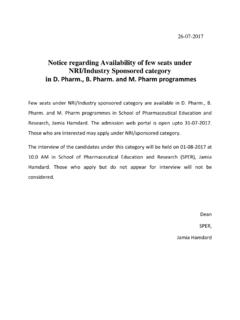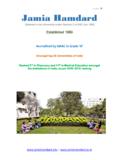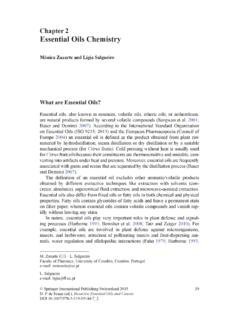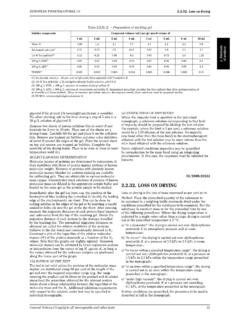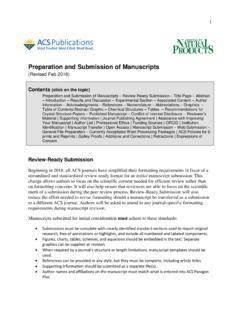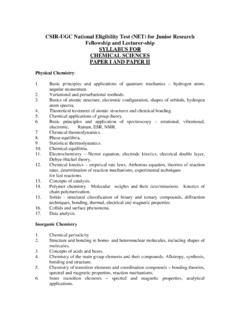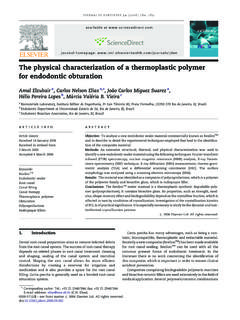Transcription of SYLLABUS - Jamia Hamdard
1 1234567891011121314151617181920 SYLLABUSFOR M. PHARMINPHARMACEUTICAL CHEMISTRY(Including the SYLLABUS of Modern Analytical Techniques{Theory & Practical} common in the Ist Semester of allBranches of M. Pharm expect M. Pharm in PharmacyPractice)21 Semester INo. of Teaching Hrs. 4 Hrs / WeekPaper MPC 101 Duration of Exam 3 Marks. 100 This Paper (Theory & Practical) is common in Ist semester of all branches of M. Pharm except in Pharmacy PracticePHARMACEUTICAL ANALYTICAL TECHNIQUESANALYTICAL TecniquesPrinciples of separation and applications of TLC. Column chromatography. Paper chromatography, Ionexchange chromatography, Counter current chromatography, , DCCC, HPTLC & HPLC Infrared spectroscopyIntroduction: The IR absorption process; the modes of vibration bond properties and absorption trends. TheHook s Law & calculations of frequencies for different types of bonds; coupled interactions; hydrogenbonding; radiation source, sample handling, qualitative and quantitative applications and introduction aboutFT-IR3.
2 Ultraviolet spectroscopyIntroduction: The nature of electronic excitation, the origin of UV band structure; principle of absorptionspectroscopy; Beer and Lambert s Law, Chromophore *, *, *and *transitions; shiftsreagents effects of substituents; effect of conjugation confirmations and geometry; calculation of Lamdamaxima, effect of solvents, qualitative and quantitative applications4. Nuclear Magnetic Resonance NMR Spectroscopy: Principle, Instrumentation techniques. Chemical equivalence, spin-spincoupling, The origin of spin-spin splitting, Pascal triangle, the coupling constant chemical shift reagentsPharm. application including interpretation of Proton-NMR NMR Spectroscopy:Peak assignments, off resonance decoupling, selective proton decoupling,chemical shift equivalence, chemical shifts and spin Mass Spectrometry:Basic principle and theory involved, Instrumentation, types of ions, fragmentation, rearrangements; massspectra of representative compounds, recognition of molecular ion peak, chemical ionization massspectrometry,field desorption mass spectrometry, mass spectrometry, fast atom bombardment Thermal analysisIntroduction to various thermal methods of analysis, basic principle and theory; differential thermalanalysis and differential scanning calorimetry and micro calorimetry.
3 Different types of calorimeters andmicro spin resonance spectroscopyIntroduction , derivative curves, -values, hyperfine splitting, ESR instrumentation, ESR spectra of freeradicals and evaluation of drugs in biological microscopy of herbal drugs. Lycopodium spore method, stomatal number, stomatalindex, palisade ratio, vein-islet number, and vein-termination Pharmacopeal analysis of AND COMPUTER treatment of data, Graphic & diagrammatic representation of of significance, Z-test, t-test, f-test, contingency table, chi-square of variance-one way, two way ANOVA and multiple comparision and Regression of ED50, LD50and probit applications22 BOOKS RECOMMENDED1. , , Spectrometric Identification of organic compounds, 6th ed. John Wiley &sons, New-York, Remington, The science and practice of pharmacy, Mack publishing company. Easton Organic spectroscopy by Willam Kemp4. E. Heftmann, A laboratory handbook of chromatography, , and , Instrumental methods of analysis, Van Nostrend Reinhold,New WWM.
4 Wenland, Thermal analysis, John Willy and sons, Principle of instrumental analysis,V ed. By Skoog, Modern analytical chemistry by David Harvey. (MC Graw-Hill international edition).9. Q. S. Ahmad, M. Vaseem Ismail & S. A. Khan Biostatistics , University Science Press, LaxmiPublications Pvt. Ltd, New Delhi, IDuration of Exam 12 MPC 102 Max. Marks. 100 PRACTICALSP racticals based on instrumental methods of analysis. A sufficient training will be given through exercisesusing different kinds of spectral No. I No. of Teaching Hrs. 4 Hrs /weekPaper MPC 103 Duration of Exam 3 Marks. 100 PHARMACEUTICAL CHEMISTRY IDRUG DESIGN INCLUDING ORGANIC NAME REACTIONS1. Physicochemical properties in relation to drug action; metabolic transformation of drugs and its role indevelopment of new drug molecules; Metabolic Stereochemical aspects of drug receptor interactions and mechanism of drug interaction.
5 Isosterism andbioisosterism as guides to structural variations; Concepts of conformational analysis and its role in designand development of new drug molecules, configuration-absolute & Principle of drug design: Analogue synthesis versus rational design; discovery of lead compounds,Pharmacophoric identification, Prodrugs and soft drug, recent developments in structure-based drug design;Molecular docking and dynamics. Rigid docking, flexible docking, manual docking, molecular modeling,molecular graphics. Computer methodologies behind molecular molecular modeling including artificialintelligence methods; Pharmacoinformatics drug QSAR, computational chemistry-its role in design and development of new drugs, Hammelt equations,lipophilicity effects, Hanseh equations and steric In organic chemistry, the following name reactions and molecular rearrangements will be discussed indetail with reference to their application in the synthesis of some medicinal agents, where possible.
6 (a) Claisen-Schmidt reaction Sulfisoxazole.(b)Perkins reaction sulinadac(c) Friedal Craft Reaction (d) Aldol condensation(e) Mannich reactions Tolmetin, Atropine, Ethacrynic acid, Dextropropoxyphen.(f) Beckmann s rearrangement.(g) Wagner-Meerwein rearrangement(h) Wittig Reaction(i) Oppenaur oxidation.(j) (Meervein-pondroff-verley) Reduction.(k) Vilsmeier-Haack reaction.(l) Michael addition6. Introduction, theory, mechanism of reaction and pharmaceutical application of drug under:i. Cycloaddition recommended1. Ariens : Drug Design, Academic Press New York (1975).2. Salkovisky. Sinkula and Valvani, Physical Chemical Properties of Drug, Marcel DekkerInc. New Wolff, Burger s Medical Chemistry, John Willey and Sons. New Doerge, Wilson and Gisvold s Text Book of Organic Medicinal and Pharmaceutical Chemistry, Co., J. March, Advanced Organic Chemistry, Reaction Mechanismand Structure, John Wiley and Sons, Gould, Mechanism and Structure in Organic Chemistry Holt, Rinewart and Winston, New II No.
7 Of Teaching Hrs. 4 Hrs / WeekPaper MPC 201 Duration of Exam 3 Marks. 100 PHARMACEUTICAL CHEMISTRY IICHEMISTRY OF NATURAL PRODUCTS1. Natural products as Leads for new The natural products obtained from terrestrial and microbial sources will be discussed in the light ofvarious degradative and synthetic approaches supported by spectral data. Important members representingthe following classes of natural products shall be introduction and classification, isolation and purification methods, general methods employed fordetermining the structure of alkaloids, constitution of ergot alkaloids, steroidal alkaloids and introduction, stereochemistry, nomenclature and structure elucidation of sterols (cholesterol),sapogenin (diosgenin) and cardiac acids and peptides, nucleic acidsGeneral introduction, synthesis of peptides and amino acids.
8 End group analysis, structural features ofInsulin, vasopressin and oxytocin, structural features of DNA & of antibiotics, structural details of penicillins and tetracyclines, polypeptide chemical account of rutin and general chemical treatment and structural elucidation of methods of isolation and purification and structural determination of xanthotoxin and Marine products with Naturally occurring Recommended1. Finar, Organic Chemistry, , The English Language Books Society and Longman Cordell, Introduction to Alkaloids, John Wiley and Sons, New Wickery and B. Wickery, Secondary Plant Metabolism McMillan Press Ltd. Fieser and M. Fieser, Steroids, Reinhold Publishing Co. New Torsell, Natural Products Chemistry, John Wiley and Sons, New Harborne, Phytochemical Methods, Chapman and Hall, London7. Burger s Medicinal Chemistry and Drug Discovery, Vol. I. Principle and Practice, 5th, Edition, JohnWiley Sons, New Carotenoids, A Handbook by IINo.
9 Of Teaching Hrs. 4 Hrs / WeekPaper MPC 202 Duration of Exam 3 Marks. 100 Pharmaceutical Chemistry-IIIM edicinal ChemistryThe following topics will be discussed keepingin view the recent and Messengers:-i. Introduction, Classification, The bonding of Ligands to structure and signal transduction : Receptor families, G. Proteins coupled receptors, Ligandgated ion channel receptors, Kinase linked receptors;ii. GABA and glutamate receptor-ligands and their therapeutic potential in CNS & Alzheimers disease:search for , Chemokine & Cytokine sex hormones, contraceptives & fertility agents-including the development inchemotherapy of AIDS and newer agent for thetreatment of HIV infection such as HIV entry inhibitors, Chemokine receptor binders, Integraseinhibitors, Inhibitors of gp41 fusion agentsincluding future anti-neoplastic agentssuch as Telomerase inhibitors,Antisense technology, Angiogenesis inhibitors, Monoclonal antibodies, Immunotherapy and Signaltransduction affecting immune of cell and Regoselective Recommended1.
10 Wolf, Brugers Medicinal Chemistry, John Wiley and Sons, New York, Vol. II , III, IV, V and VI2. Doerge, Wilson and Gisvold s Text Book of Organic Medicinal and Pharmaceutical Chemistry, Foye, Principles of Medicinal Chemistry, Lea and Febiger, Lednicer and Mitschler, Drug synthesis, , II & Martindale, The Extra Pharmacopoeia, Pharmaceutical Press, London6 T, Albert, Selective Toxicity, Chapman and Hall, Burger s Med. Chem. & Drug Discovery, Vol. Monographs and relevant Review articles appearing in various periodicals and IIDuration of Exam 12 HrsPaper MPC 203. Max. Marks. 100 PracticalPracticals based on some topics covered in the theory part including synthesis of medicinal compounds andanalysis of organic mixtures will be carried IIIP aper MPC 301 Max. Marks. 100 PracticalPractical based on synthesis and spectral analysis of some medicinal of Research ProjectSeminar and viva voce on research methodology andresearch IVPaper MPC 401 Dissertation300 marksViva voce200 marks25 SYLLABUSFOR M.
